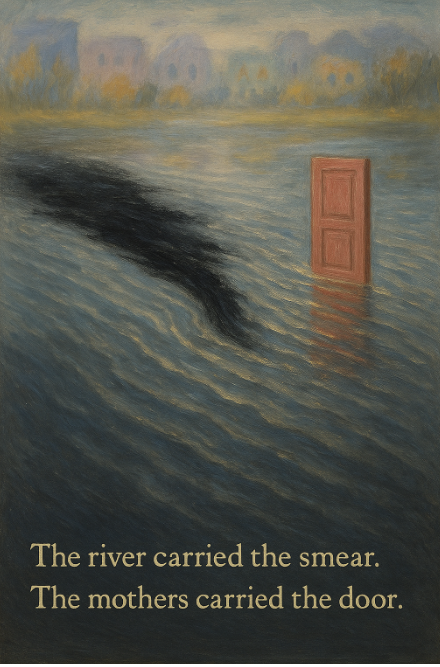
July 5, 2026 — Dawn over Srinagar
The Jhelum woke in ribbons of rose and ash, its surface catching the first light like a canvas before the brush. In the courtyard, the Srinagar mural stood unveiled—a sky of violet mist cradling a ghost chinar, its open door glowing in soft rose. In Jammu, Neelam’s valley floor bloomed with emerald mosques and temples, a cherry blossom drifting in silver. In Muzaffarabad, a child’s cherry tree rose against a ridge, its petals caught in the same river’s breath.
The Circle had returned at dusk the night before, their silence heavy with Grandfather’s letter. Emil placed the gray stone from the bridge on top of the Quiet Box, its weight a quiet vow.
He reread Grandfather’s line:
“You gave them a place to miss themselves—together.”
Then he opened the Quiet Box.
“Today,” Emil said, “the mirrors speak.”
The Unveiling
By noon, the courtyard filled—not with crowds, but with witnesses. Elders, youths, mothers cradling infants. No banners. No speeches. Only the murals, the river’s murmur, and Zohair’s recorded refrain looping softly:
River, keep the names / River, keep them safe.
A Srinagar girl touched the chinar’s door. A Jammu elder traced the mosque’s dome. Via encrypted video, a Muzaffarabad boy pointed to his cherry tree. Mina’s projection pulsed gold across all three walls—312 named homes, one breath. Aisha stood back, her hands stained with rose and gold, watching the valley listen to itself.
Dr. Basit arrived, his voice low:
“They will speak of this.
Not all will speak kindly.”
The Whispering Begins
That afternoon, the rumors began—not shouted, but passed in glances, in lowered voices at tea stalls, in encrypted group chats.
“They’re mapping homes to claim them.”
“The UN is using art to redraw the Line.”
“This is not memory. This is politics.”
A local education officer—known for his cautious loyalty—visited the Srinagar site. He studied the chinar, the open door, the gold pulse in the river. Then, to Emil:
“You are reframing the story.
Whose valley is this?”
Emil did not answer with words. He opened the Quiet Box.
A slip fell:
My mother’s lullaby is in the river.
I hear it in all three walls.
The officer read it. Said nothing. Left.
The First Defacement
July 7, Jammu.
A black smear appeared across the mural—blotting out a mosque’s open door. No note. No witness. Just absence, made visible.
Neelam arrived at dawn.
She did not call the Circle.
She did not call the police.
She called three mothers—one Pandit, one Muslim, one Sikh—who had lost homes in different decades.
They came with rags, turpentine, and small brushes.
They did not repaint the door.
They washed the smear into the river’s silver current, letting the black fade into gray, then into water.
Then, together, they painted a new door—smaller, lower, in the exact rose of Neelam’s sari.
No one spoke.
The river did the speaking.
By noon, the mural breathed again.
A child left a slip in the Jammu Quiet Box:
The door is smaller now. But it is ours.
The Circle’s Silence
In Srinagar, Emil received the photo.
He showed it to Aisha.
She dipped her brush in gold and added a single pulse to the Srinagar river—matching the restored door in Jammu.
Priya drafted no statement.
Mina archived no data.
They simply waited.
The media began to stir—local outlets, then regional:
- “Controversial mural project divides Kashmir.”
- “Art or agenda?”
But the mothers had already answered.
That evening, as the valley dimmed into indigo, Emil opened the ledger beneath a flickering light.
They tried to erase a door.
The mothers opened it wider—quietly.
📜 Ledger Entry — The Mirror of Valleys (Part I)
Date: July 8, 2026
Symptom: Murals unveiled across tri-valley corridor. Public response fractures between awe and suspicion. Vandalism in Jammu subtly corrected by mothers. Emotional trust quietly upheld amid external tension.
Disease — The Four Absences (Tri-Valley Context)
- Absence 1 — Exclusion
Memory is seen as territorial; “whose story” becomes a proxy for ownership. - Absence 2 — Vengeance
Grief weaponized as accusation; the black smear performs as symbolic protest. - Absence 3 — Dehumanization
The Circle is labeled “agents”; mothers remain invisible until they reclaim space through quiet care. - Absence 4 — Unheard Cry
Named homes are threatened by silence; the restored door becomes a re-voicing of dignity.
Investigator’s Response
- Unveiled murals without declaration; emphasized witness over celebration.
- Absorbed criticism without defense, allowing local context to interpret.
- Allowed organic, community-led restoration by affected families.
- Sustained tri-valley alignment through visual continuity (gold pulse).
Outcome
- Mural briefly scarred, quietly healed.
- Three mothers become agents of cultural resilience.
- Rumors rise, but murals remain intact.
- Emotional architecture holds, even as political winds shift.
Note
The river carries the smear.
The mothers carry the door.
The wound breathes — quietly.

